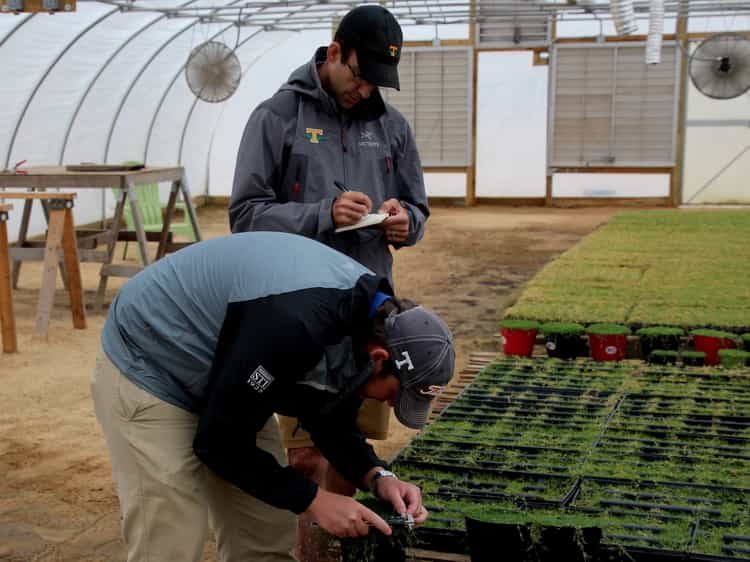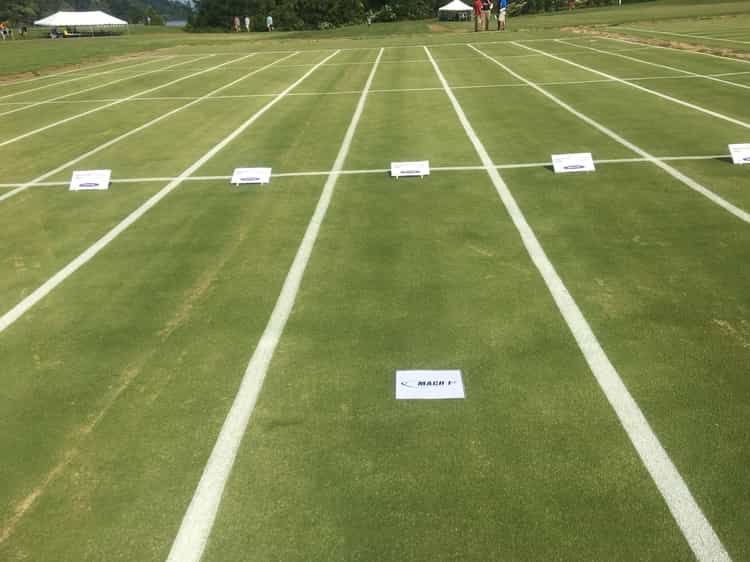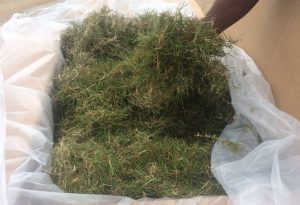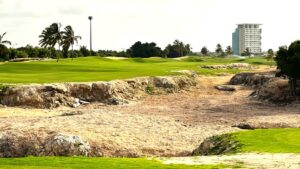Just as the game of golf has evolved over the years, putting green turfgrasses have changed significantly with time and technique. An example of this evolution is ultradwarf bermudagrass. Born out of the desire for faster, firmer, and more consistent putting surfaces, new and improved ultradwarfs, such as Mach 1™, continue to be introduced and remain the most popular putting green grasses in warm season and transitional locations.
The History of Ultradwarf Bermudagrass
The short history of ultradwarfs begins with the bermudagrass Tifgreen, released in 1956. This breakthrough turfgrass owes its origins to Dr. Glenn Burton, who used USGA funding to cross-pollinate African and common bermudagrasses, producing a hybrid with traits that set the new standard for greens. Tifgreen’s drawback – and lasting legacy – was its prolific tendency to mutate genetically, creating new and varied plants, many with appealing characteristics for putting greens.
Many varieties introduced in the 1990s continue to be ultradwarf stars.
James B. Moncrief, director of the USGA Green Section’s Southeast Region at the time, collected a naturally occurring mutation of Tifgreen that became Tifdwarf. Released in 1965, Tifdwarf possessed a darker green color and the ability to tolerate lower mowing heights.
This pattern of development continued for some thirty years before the first ultradwarfs premiered. The 1990s saw the introduction of the varieties that continue to be today’s major ultradwarf stars. MiniVerde™ and Champion were both selections from naturally occurring mutations in Tifgreen, and TifEagle was created from the process of mutation breeding.
All three possess characteristics that established even higher standards for putting green quality. Finer leaf blade, greater density, increased upright growth, and tolerance for still lower heights of cut differentiated ultradwarfs from their predecessors and delivered smoother, firmer, and faster greens.
Selecting among the ultradwarf choices for new and renovation projects requires consideration of multiple variables. Climatic conditions, geographic location, shade, and water supply all matter, as do the maintenance budget and superintendent skill level. Realistic assessments of these factors need to be combined with a clear understanding of the benefits and limitations of the varieties.
- TifEagle is the most popular of the ultradwarfs and boasts the best shade tolerance of the three, but produces more grain and is the least cold tolerant.
- Champion has a high-density shoot growth pattern, which results in an excellent putting surface, but has a more shallow root system causing problems for turf managers during times of stress. Champion also performs less than optimally on greens with heavier organic content.
- MiniVerde tends to have the deepest roots and the fastest green speeds but is not especially shade tolerant.
Managing Off-Types
An ultradwarf concern affecting all three varieties is the possibility of mutations and off-types. This issue should not be a surprise considering that all ultradwarfs are the product of mutations, either naturally occurring or through mutation breeding. Some off-types produce little or no effect and fail to thrive due to low heights of cut and other maintenance practices. However, many off-types create concerns through noticeable differences in color, growth rate, or texture compared to the original turfgrass.
As ultradwarf varieties matured and off-types emerged, attention began to increase. Dr. Jim Brosnan, turfgrass weed scientist at the University of Tennessee and his graduate assistant Eric Reasor launched a study of the problem.
“Considering the amount of ultradwarf grown in the Southeast and its increasing demand, this is a good place to focus research,” said Reasor. “Off-types are a fundamental weed management problem.”
Collecting over 50 off-type samples from 21 golf courses across the Southeastern United States, the team included sources of every type: old and new greens, renovations and new designs, intensive and minimal management programs, and varying maintenance budgets. Results showed that all of the off-type samples were within the Tifgreen-derived cultivar family, and none of their particular samples were cross-contaminants from other areas of the golf course.
“All ultradwarf varieties exhibit various forms of self-contaminated off-types,” Reasor said. “Ultradwarfs were derived from mutations themselves, and no variety is immune to off-types.”
Accurately sourcing the origin of off-types (contamination in the production field; on-site contamination from collars, roughs, or fairways; or genetic mutations developing on-site) is not simple, but precautions can be taken. At the onset of a project, buying turfgrass from quality sources with a proven record of providing clean material is key. Reasor also recommends visiting production fields as well as courses that have grown the desired variety for some years.
For projects where off-types are occurring, the second part of Brosnan and Reasor’s research comes into play.
“We are looking at off-type responses to growth regulators and nitrogen, both commonly used to manage putting greens,” said Reasor. “By studying rates and dosages and preferable management practices, our goal is to provide superintendents, architects and the entire turfgrass industry with solid data and research-based strategies to successfully manage off-types.”
The Newest Ultradwarfs
The quest for ever better quality and easier managed putting greens continues. Two of the newest commercially available ultradwarf bermudagrasses gaining popularity are Mach 1 and Sunday.
Mach 1™ Ultradwarf Bermudagrass
Mach 1 Ultradwarf Bermudagrass, developed by Certified Golf Course Superintendent Rod Lingle, sets itself apart from previous ultradwarf releases with super fine texture for superior ball roll, excellent response to growth regulators, and incredible visible purity. Mach 1 has been characterized as one of the cleanest and purest turfs throughout its growth period.
As part of Mach 1’s introduction to the market, courses around the world from Florida to Vietnam planted trial plots for evaluation. Trump National Golf Club Charlotte in North Carolina was the first to install the new ultradwarf for permanent play. Their new Fazio-designed par-three practice facility, Fazio Five, features Mach 1 on all greens.
Mach 1 Ultradwarf is a really tight looking plant, upright with excellent color and good, thick, healthy roots.
James Sowers
“We were surprised at how quickly the Mach 1 grew in,” said Trump National Director of Grounds James Sowers. “We planted in June for a September grand opening, but the greens were almost completely covered in just six weeks. I have also noticed that we aren’t getting as much vertical movement as lateral growth, which has been positive for the speed of the greens.”
Streamsong Resort in Bowling Green, Florida selected Mach 1 for the Streamsong Blue greens renovation. As a three-course resort facility hosting about 100,000 rounds of golf per year, Streamsong requires greens that can impress.
“I would say Mach 1 is probably the finest putting surface I’ve seen in my life,” said Rusty Mercer, director of agronomy at Streamsong. “I don’t know if I’ve seen a surface this fine and tight before. It’s almost like the ball is floating.”
Mercer, who is experienced in managing ultradwarf greens, described Mach 1 as less labor-intensive than TifEagle. He found Mach 1 to be drought and disease resistant with a giant root system and requirements for less nitrogen.
I would say Mach 1 is probably the finest putting surface I’ve seen in my life.
Rusty Mercer
“I haven’t found anything that I don’t like about this grass,” said Mercer. “I’ve had superintendents from all over the country visit, and they were blown away. They all try to compare it to something they’ve played before, but no one can come up with anything like it.”
Genetic stability is an advantage of Mach 1 getting attention as well. Lingle selected the grass nearly 20 years ago. Throughout testing and trials, no visible off-types have occurred.
Sunday Ultradwarf Bermudagrass
Sunday™ Ultradwarf Bermudagrass was selected for its dense growth canopy, lighter color, and reduced seed heads. NTEP trial results show positive advantages in establishment, ball roll, fall color retention, and recovery from injury.
Shannon Easter, director of golf maintenance and environmental consultant at The Broken Sound Club in Boca Raton, Florida, became familiar with Sunday long before its commercial release. In 2003, he joined Craft Farms in Gulf Shores, Alabama, where the Sunday greens were already 18 years old. In his seven years there, he did not experience a single mutation.

“During my career, I’ve managed Tifgreen, TifEagle, Champion, Tifdwarf, and Floradwarf greens,” said Easter. “Sunday greens were the first in my experience where I did not see mutations.”
Sunday greens were the first in my experience where I did not see mutations.
Shannon Easter
Moving to Broken Sound in 2012, Easter wanted to see if Sunday would perform as well in South Florida. He planted a large test green last summer and implemented identical maintenance practices as the club’s two courses featuring TifEagle.
“Sunday outperformed TifEagle in cool season color, height of cut, and green speeds and has two-thirds more root mass,” said Easter. “Sunday also recovers better from verticutting and aerification, and requires less fungicide.”
Based on the test results, Easter chose Sunday for Broken Sound’s Club Course greens renovation in 2018.
The Ultradwarf Bermudagrass Evolution Continues
As ultradwarfs continue to advance and research brings about more effective maintenance practices, opportunities for ever-improving golf greens do not end. The evolution continues.
SaveSave
How can we help you today? We are happy to provide you with more information about Ultradwarf Bermudagrass and how it can benefit your facility. We’re here to answer any questions you may have.
John Holmes
President, Atlas Turf
SaveSave







